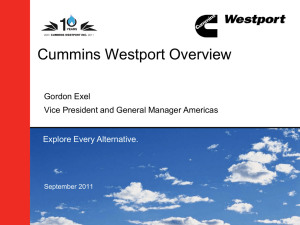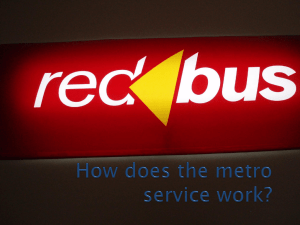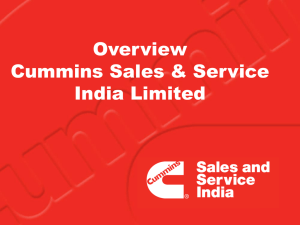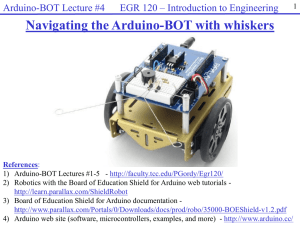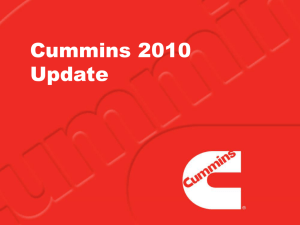Make Every School Bus Better.
advertisement
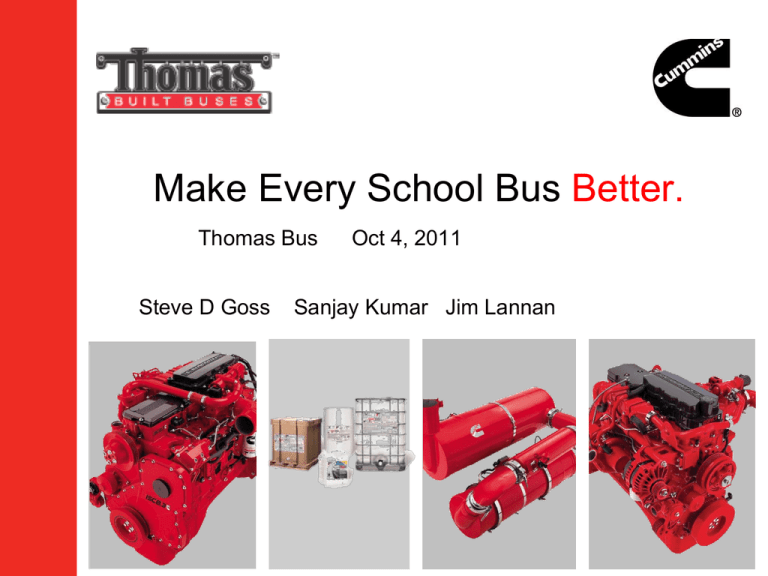
Make Every School Bus Better. Thomas Bus Steve D Goss Oct 4, 2011 Sanjay Kumar Jim Lannan Agenda 1. Update on successes 2. IC Bus ‘Fluid’ Economy Claims 3. Cummins Fuel Economy 4. How to sell Cummins School Bus Industry Data Industry data suggests a 5% gain in Cummins market share (50% to 55%) Recently gained business with largest bus customer IC Bus ‘Fluid’ Economy Claims IC Bus published report of fuel economy testing stating ‘up to a 4.5%’ advantage vs Cummins Cummins responded to claims outlining the points in question including: – Transmission shift calibration selections – Aftertreatment regeneration ‘Fluid Economy’ also ignores the price differential Avg. Diesel Price Avg. Bulk DEF Price $3.80 $2.85 Transmission shift calibrations IC Bus did not outline what shift calibrations were used during testing Cummins testing validates that proper selection can result in significant fuel economy gains Aftertreatment Regeneration Typical regen cycle on MF 7 at approx. 135 miles – Same distance as test More EGR = More Soot Generated = More Regens Regenerations require the use of more fuel thus diminishing overall fuel economy ‘Fluid’ Economy IC’s claims of ‘fluid’ economy inaccurately represent total cost of ownership No mention of DEF consumption thus inability to analyze actual DEF usage for test Differences in DEF and diesel fuel pricing vary significantly so need to be analyzed separately Cummins Fuel Economy ‘Others Test. We Deliver’ Cummins and Thomas Bus both currently testing ISB Fuel Economy Tops DTNA Testing Freightliner M2 106 with Cummins ISB (EPA 10) Vs. International Durastar 4300 with MaxxForce DT (EPA10) Result • 8.5% Better Fuel Economy • 2 Regens for ISB Vs 10 for MaxxForce DT in the 14 hour test period In Cylinder NOx Control Challenges Fuel economy significantly compromised Increased risk of EGR condensation Significant increase in heat rejection Complex system integration Driver satisfaction significantly compromised Power density and torque limitations In Cylinder NOx Control Challenges Fuel Economy Significantly Compromised 5-9% disadvantage Combustion efficiency degradation: – Higher engine pumping losses – Increased intake & exhaust manifold pressures – Increased Particulate Filter regenerations In Cylinder NOx Control Challenges Increased Risk of EGR Condensation Higher EGR flow produces excessive acidic condensation Power cylinder corrosion – Rapid deterioration of lube oil Reliability and durability compromised In Cylinder NOx Control Challenges Significant Increase in Heat Rejection 20% increase Higher EGR flow: – Multiple EGR coolers on & off engine – Larger vehicle cooling package – Major redesign of radiator / Charge Air Cooler / Fan systems In Cylinder NOx Control Challenges Complex System Integration Higher EGR flow Air handling system Vehicle cooling system In Cylinder NOx Control Challenges Driver Satisfaction Significantly Compromised Higher EGR Flow – Throttle Response In Cylinder NOx Control Challenges Power Density and Torque Limitations Deterioration of 50 – 100 hp for same displacement Higher EGR flow & EGR controls compromises engine performance Bus Owners Have Two Choices for 2010 Advanced EGR Radiator Intercooler Clean Air DOC DPF Higher heat rejection: Larger Radiator Larger Charge air cooler EGR + SCR After-Treatment System Setup Catalyst DOC DPF AMOX Cat Doser Tank Emissions Control Technology NOx is converted into N2 and H20 downstream from the engine using a diesel exhaust fluid catalyst Exhaust gas is re-circulated through the cylinders reducing peak combustion temperature, lowering NOx emissions SCR allows for a lower EGR run rate, EGR introduces excessive carbon and increasing fuel economy and engine life soot into the cylinder, causing pre-mature liner and piston wear With emission controls moved out of and away from the engine, power generation is unhindered Higher EGR cooling capacity strains the cooling system, leading to shorter coolant change intervals and component failure The Facts about the Fluid – DEF Properties DEF is safe to handle and store – Non-toxic – Non-polluting – Non-flammable Acidic pH DEF freezes at 12° F (-11° C). However, frozen DEF does not impact start up and normal operation of the vehicle When stored at extreme temperatures, neither DEF nor Urea become toxic DEF is slightly alkaline with a pH of approximately 9 19 DEF DEF - Myths & Facts Navistar’s claim of ammonia level being close to 1000 ppm in a near empty DEF tank is a ‘stretch of imagination’ DEF, when heated and maintained at a constant temperature 120 degrees Fahrenheit, will very slowly start to form small amounts of ammonia It would take over two years at this constant temperature to convert DEF into levels of 1000 ppm of ammonia Such a situation can be probably modeled in ‘laboratory setting’ but not in the real world Cummins ISB6.7 vs Navistar MaxxForce 7 Competitive Comparison Cummins ISB6.7 vs. MaxxForce 7 Cummins Advantage Feature Displacement Configuration Horsepower 6.7L Inline 6 200 - 325 HP 6.4L V-8 200 - 300 HP Fewer parts / better reliability Better power density Better power Torque 520 -750 lb-ft 560 - 660 lb-ft Aspiration One - variable geometry turbo (2) dual stage Fewer parts / turbos better reliability Oil change 15,000 mi. 10,000 mi. interval (24,000 km) (16,000 km) Lower maintenance cost / better uptime Engine weight (dry) 1,150 lb (522 kg) 1,225 lb. (556 kg) Lower weight density Competitive Comparison Summary Feature Cummins ISB6.7 Advantage MaxxForce 7 Complexity Single VG turbo, single radiator & charge air cooler Dual turbos, multiple charge air coolers and radiators, large EGR cooler Emission Controls Diesel Particulate Filter and Selective Catalytic Reduction Diesel Particulate Filter and Advanced EGR 15,000 mile service intervals and 3,500 authorized service locations 10,000 service intervals and 900 authorized service locations Maintenance and Service Designing For the School Bus Market Reliability Total cost of ownership Low maintenance Safe Operation Sociability Performance Weight/space Minimal driver training Ease of operation Information systems Emissions compliance Cummins Diesel Power ISB6.7 & ISC8.3 Features Improved combustion system Advanced VGT Turbocharger Improved cooled-EGR subsystem/cooling circuit Fully integrated electronic controls New Cummins Aftertreatment System ISB6.7 & ISC8.3 Customer Benefits Best-in-Class Fuel Economy Improved Reliability Minimal Installation Impact Stronger Performance Increased Power Density Cummins Natural Gas Power ISL G Product Features and Benefits 8.9L Stoichiometric Cooled EGR engine with spark ignition In production since mid-2007 Low emissions Diesel-‘like’ Performance, Reliability and Durability Over 80% parts commonality with ISL9 Compatible with CNG, LNG, or Biomethane (RNG) 29 2010 ISL G Natural Gas Stoichiometric Combustion Cooled EGR Three Way Catalyst Aftertreatment – Same rated speed as ISL9 diesel – Passive device – 30% more torque at idle – Maintenance-Free – 5% better fuel economy – Packaged as a muffler Integrating Critical Subsystems Filtration and Diesel Exhaust Fluid Electronic Controls Combustion Technology Aftertreatment System Turbochargers Fuel Systems PowerSpec Software Application – Provide gearing recommendation – Customize engine ‘specs’ – Collect valuable trip information – Free to download and use www.powerspec.cummins.com 32 INLINE™ adapter Cummins datalink adapter used in conjunction with PowerSpec Allows user to: – transfer feature parameter settings – download trip information INLINE™ 5 kit (part number: 4918416) includes all necessary parts to connect the vehicle to a laptop 33 Make Every School Bus Better. TM Better Fuel Economy. – Up to 3% better than our ’07 ISB and ISC – Joint testing underway on EPA 2010 product Better Performance. – Improved driveability and throttle response Better Reliability. – Best-in-class durability and dependability Better for the Environment. – Near zero NOx and PM emissions – Improved MPG results in smaller carbon footprint Saf-T-Liner EFX 36 Common Parts with HDX means faster design cycle Sub-system ID (estimated number of parts to be eliminated ~100) Front Roof Cap (6) Destination Sign (20) #2 Hood (2) Clearance/Marker Lights (6) Windshield (3) Wipers (15) Header Height/Drip Rail (4) “A” Mirrors (8) Hazard Lights (4) “B” Mirrors (8) Bumper (10) 00000-00-Thomas Built Buses Standard Template.ppt Walk Gate (8) Headlight & Bezel (4) 37 Driver Focused Improvements Storage • Added driver’s storage to right side dash • Can be used for safety equipment storage or for personal items 00000-00-Thomas Built Buses Standard Template.ppt 38 Driver Focused Improvements Visibility • Improved visibility • HDX windshield • Larger driver’s side window • Argosy headlights • Running lights standard 00000-00-Thomas Built Buses Standard Template.ppt 39 Driver Focused Improvements Visibility • Improved defrost capability 00000-00-Thomas Built Buses Standard Template.ppt 40 Technician Focused Improvements - Access • Headlight doors and removable grill provide easy service access • Lights • Wiper motors and linkages • Washer fluid • Power steering reservoir • Defrost heater relays 00000-00-Thomas Built Buses Standard Template.ppt 41 Technician Focused Improvements - Access • Lower driver side access panel for chassis PDM’s 00000-00-Thomas Built Buses Standard Template.ppt 42 Technician Focused Improvements – Misc. • More reliable components should translate to fewer replacements • Increased parts commonality means less parts for technician to maintain • Bus can still be jacked up by front bumper 00000-00-Thomas Built Buses Standard Template.ppt 43 Family Look HDX 00000-00-Thomas Built Buses Standard Template.ppt EFX 44 EFX Status Gate 9/8 Status: Passed (May 9th) Gate 7/6 Status: Passed Scheduled SOP: Q1 2012 Project Budget approved. Bus to be showcased at NAPT in October. Estimated start of production 1Q2012 Pilot/Preseries We’ll be soliciting orders within the next month Will come with new sales codes – WebEx will be scheduled to assist in ordering process Will come with $300 cost increase Design Validation Cooling passed. FEA and fatigue analysis in progress. Defrost testing planned for early October 6000 mile durability to begin mid-September at Bosch Proving Grounds. 00000-00-Thomas Built Buses Standard Template.ppt 45 Questions? Thomas Built Buses Dealer Sales Meeting 2012 46


